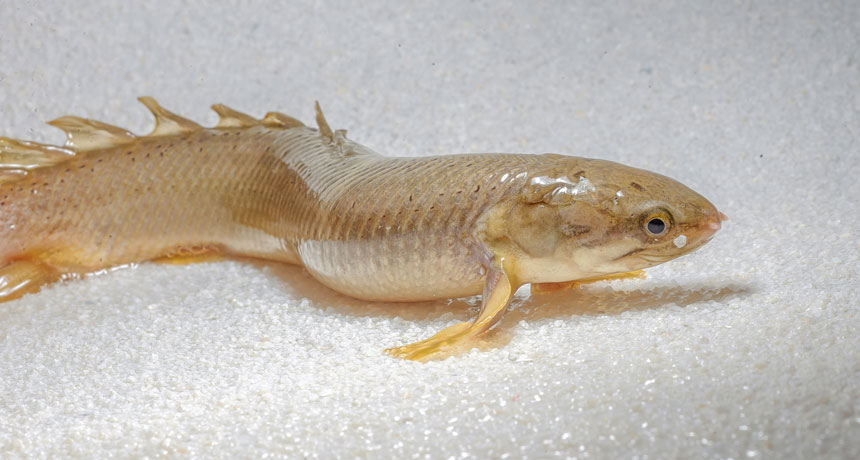
Bichir fish (Polypterus senegalus) living on land. Photo: Antoine Morin
Bichirs: Archaic-Looking Fish Raised on Land
This is a fish called a Bichir (Senegal Bichir, Polypterus senegalus). Bichirs are found in Africa, and like all fish, they live in water; that is until they met researcher Emily Standen, who was working at McGill University in Canada.
Standen thought that she would try raising Bichir on land. Why you ask? To see if helps them walk. It isn't quite as mad as it sounds; let's go back a step.
Bichirs, unusually among fish, actually have lungs as well as gills so they can breathe air. But having lungs, doesn't mean you can walk, as demonstrated by this lungfish's failed attempt at perambulation. But there are fish that do take tentative steps onto land. Arguably, the masters at fishy walking on land are these; mudskippers. Bichirs too can make flappy forays over land, but they walk in a very different way. In fact, scientists think they walk like the ancestors of all tetrapods might have walked; fishapods if you will. Studying how they react to a terrestrial environment could help us understand how the very first fishy footsteps were taken on land.
Standen's Bichirs grew up in a decidedly damp, but totally terrestrial environment. She and her team set up some high-speed cameras, placed the Bichirs on a stage, and let them go. They compared their walking abilities with those of Bichirs raised more traditionally – you know, in water – and they saw some differences; subtle, but distinct. The land-lubbers lifted their heads higher, planted their fins more fins more efficiently, and slipped less often than their aquatic associates.
This suggests that Bichirs have the ability to modify their behavior in response to their environment; a concept called plasticity. This is the first time that plasticity has been shown to be a potential facilitator of such a major evolutionary step as our ancestors crawling out of the seas and onto land. But it doesn't stop there.

Pictured: Emily Standen with Bichir fish (Polypterus senegalus)
When Standen examined the skeletons of her land-living Bichirs, she found that their muscles and bones had changed as they adapted to walking. It appears that the Bichirs anatomy is as plastic as their behavior. These changes look strikingly similar to the kinds of changes scientists see in the fossil record as ancient species started making the transition to land.
It might not look elegant, but don't be decieved. After all, one small flappy step of our fishy ancestors may have led to the giant leaps of mankind.
This study is published in Nature.


